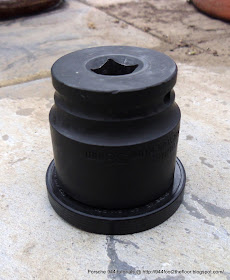The trouble with fluid leaks is that it often takes some work deducing what fluid is leaking (water, engine oil, brake fluid, power steering fluid - to name a few) and where it is coming from. Having previously cured and therefore eliminated two fluid leaks on my 944 (power steering reservoir bottle and one from the OPRV Oil Pressure Relief Valve area) I was determined to get to the bottom of the next one. In this particular case unlike the previous fluid leaks (somewhere above the removable engine floor pan) this one was clearly coming from the rear of the engine and making its way down the back of the grilled engine sump. Being the middle of the week I thought I'd make a post on the Pelican Parts forums to see if anyone had some ideas as to where I should be looking. The response was fantastic.
THE TASK
10mm Socket
Small/Medium Socket Ratchet
Small/Medium Torque Wrench
Multi-purpose engine grease
800 Grit Emery Paper
Degreaser
Camshaft Gasket ( Part No. 9281058902 )
THE HOW TO
(Amateur mechanic job time approx: 1-2 hours)
Here's the picture I posted to the Pelican Parts forums, you can see the dark oily trail down the back of the grilled sump.
As I said earlier the response by the board members was fantastic and if you read the post it seemed pretty clear the oil was coming from one or more of four possible places.
The possibilities were:
A.) The cam gasket housing
B.) The lower balance shaft plug o-ring
C.) Balance shaft housing to block sealant
D.) Oil pan gasket
Judging by the discussion, possibility 'A' was the first thing to check after having taken photos of all the surrounding areas. Apparently the gasket is made of cork and doesn't have particularly long lifespan. Here's a picture to show the culprit area.
The cam gasket sits between the cover and the main head block at the back of the engine bay (circles below).
The easiest way to check if it is leaking is to get you fingers under the lowest edge of the cap and check for oily matter running down the back of the block. If like me you find some then wipe it dry and then give the car a good drive before you check again. If the oil has returned you know the gasket needs replacing.
As per a suggestion on the forum I followed the description on Clarks Garage (right at the bottom of the article titled "Rear Cam Housing Gasket Replacement)
Removal of the cam gasket and cap is fairly straight forward and involves undoing 3 x 10mm bolts, the lowest one is a bit difficult to get to so you will probably need a small 10mm socket and ratchet. With the three bolts undone and a little wiggle the cam cap and attached engine hoist loop will come off in your hands.
As you can see from the following two pictures there is a clear amount of oil present on the lower edge of both the engine hoist loop and cam cap cover.
(Engine Hoist Loop)
(Cam cap cover)
Now turning the cap over shows the charcoal-like remains of the cork gasket itself
Without scratching the metal surface of the cap try to remove the old pieces of gasket with a blunt object like a plastic scraper or bicycle tyre lever.
Here's a picture of the new OEM gasket from Porsche.
And here it is alongside the cleaned-up cap
Now take a small amount of engine grease and lightly coat one side of the gasket before aligning it on top of the cap. This helps create a good seal as well as aiding the re-installation procedure.
Next I cleaned up the surface of the engine block with some blue tissue paper making sure there was no old bits of gasket, oil or dirt.
Before installing the cap make sure you apply some more grease to side that will pressing against the block as well as remembering to attach the engine hoist loop. Do all three 10mm bolts up to finger tightness and then STOP.
This bit is very very important. The bolts must be correctly tightened using a torque wrench to 8 Nm (6 ft-lb). This is very important to make sure the cap seals evenly all round. Again I would suggest you get yourself a small/medium sized torque wrench as the bottom 10mm bolt is very awkward to get to.
And finally a picture to show the finished result.






















